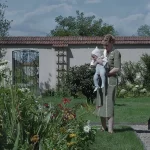Trim the Fat, by David Bax
There are plenty of paths a filmmaker can take to creating a worthwhile movie. One of the most successful is to have a good story filled with good characters and tell it well. Anne Sewitsky’s feature debut, Happy, Happy is a sad case of a picture that has all those elements in place and still manages to blow it. Sewitsky simply and plainly is trying too hard to stand out when she could have done so based solely on what she already had.
Happy¸Happy is the story of a couple named Sigve (Henrik Rafaelsen) and Elisabeth (Maibritt Saerens) who move from the city to a small town with their son. Their new neighbors are Kaja (Agnes Kittelsen) and Eirik (Joachim Rafaelsen), longtime rural residents who also have a young boy. We learn early on that the city couple’s move is an attempt to start over after Elisabeth had an affair. In short order, though, it’s Sigve and Kaja, the two homemakers who are housebound all day, who are carrying on.
To this story, Sewitsky and her writers have added two recurring flourishes that mar what is otherwise a very good film. The first is a game played by the two young boys. Kaja and Eirik’s son, Theodor, is blond-haired and blue-eyed while Sigve and Elisabeth’s adopted boy, Noa, is black. Theodor insists throughout the film that he play master to Noa’s slave. There are a multitude of scenes wherein Noa carries heavy objects on his back while Theodor yells at him or Noa has his hands bound while Theodor pretends to whip him. Given that one of the film’s central ideas is the notion that, in a relationship between two people, one often has more power than the other, this slavery element is not thematically out of place. Yet Sewitsky uses it mostly for uninspired black comedy, straining to be outrageous but arriving at pathetic.
The film’s other needless adornment is the baffling inclusion of a barbershop quartet of sorts. Their non-diegetic appearances, in which they sing Appalachian folk songs or the like, serve as loose chapter breaks. Their incorporation into the movie serves no purpose other than to remove the viewer from the story he or she was previously invested in. Maybe they’re friends of the director or something. It’s the only reason I can think of.
When the story is allowed to proceed uninterrupted long enough to get its legs under it, things get a lot better. There are four main characters named above and the movie begins with Sigve and Elisabeth driving to their new home. As things go on, however, Kaja begins to emerge more than anyone else as the film’s true lead. Agnes Kittelsen is more than equal to the task, turning in a simply wonderful, breathtaking, heartbreaking performance as a woman who has spent her entire life attempting to attain happiness by doing what is expected of her and not what she wants.
Kaja is a compassionate person. She very much wants everyone else to be happy and be comfortable, even to her own detriment. The movie’s chief concern is its characters’ struggle to find a balance between that kind of compassion and the necessity of doing what it takes to keep yourself satisfied in life. Trite as it may seem, it arrives as the conclusion that honesty is the best policy and it gets there by observing its characters first engaging in dishonesty of every stripe.
The main body of Happy, Happy is a very good film. Still – and though it’s already refreshingly brief at only 88 minutes – it could have been shorter. Sewitsky needed only to trim the forced eccentricities, the things she thought made her film unique, and rely on the simple but meaningful things that could have made her film great.






























Fwiw, I disagree about the “barbershop quartet.” I don’t recall what they sang but I don’t think they were Appalachian folk songs. At least one, as I recall, was blues or gospel number. In any case, the film is a dark comedy and the chorus was intended as a comic variation on the ancient device of the Greek chorus. We were meant to understand them as an external expression of characters’ emotions and to take it with a degree of irony.